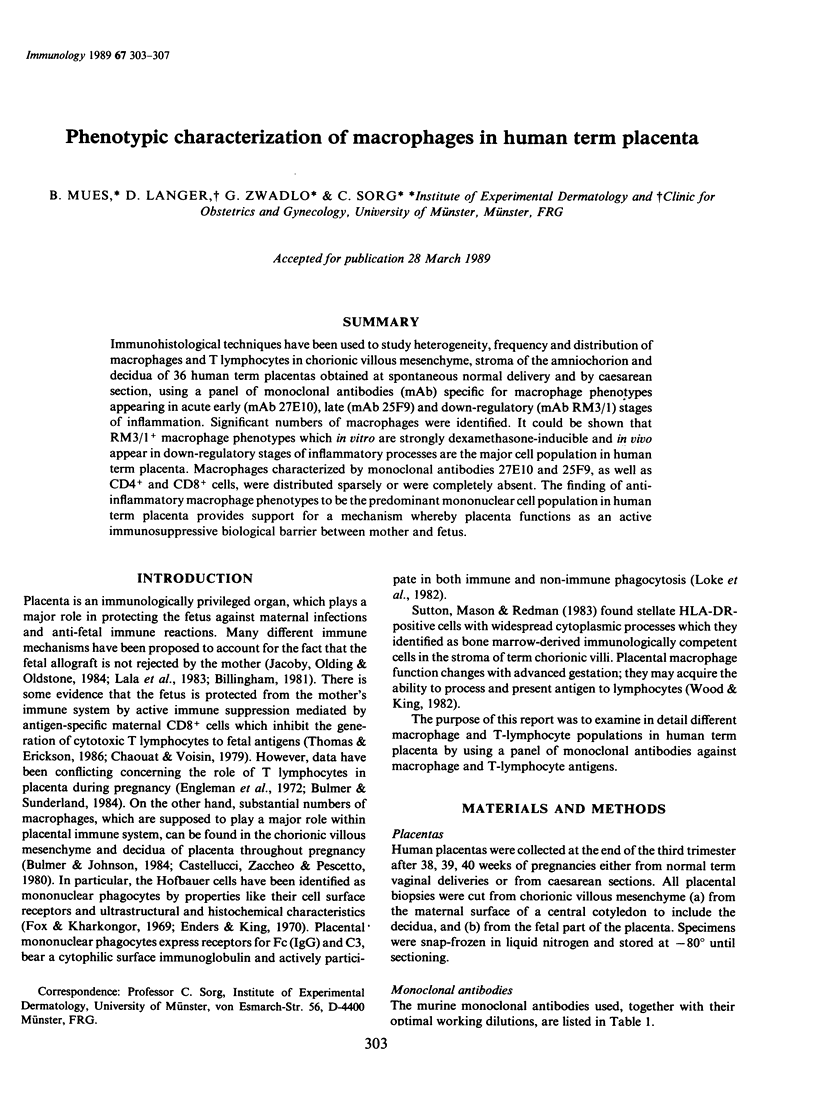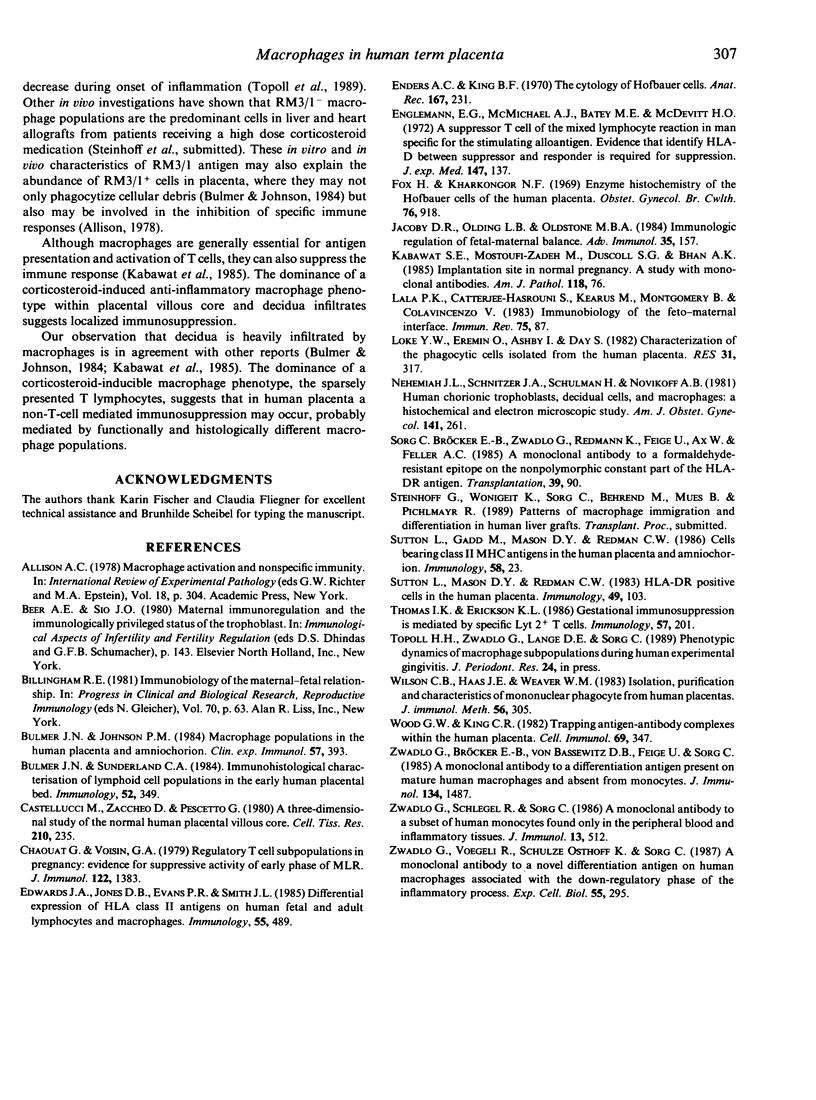Abstract
Immunohistological techniques have been used to study heterogeneity, frequency and distribution of macrophages and T lymphocytes in chorionic villous mesenchyme, stroma of the amniochorion and decidua of 36 human term placentas obtained at spontaneous normal delivery and by caesarean section, using a panel of monoclonal antibodies (mAb) specific for macrophage phenotypes appearing in acute early (mAb 27E10), late (mAb 25F9) and down-regulatory (mAb RM3/1) stages of inflammation. Significant numbers of macrophages were identified. It could be shown that RM3/1+ macrophage phenotypes which in vitro are strongly dexamethasone-inducible and in vivo appear in down-regulatory stages of inflammatory processes are the major cell population in human term placenta. Macrophages characterized by monoclonal antibodies 27E10 and 25F9, as well as CD4+ and CD8+ cells, were distributed sparsely or were completely absent. The finding of anti-inflammatory macrophage phenotypes to be the predominant mononuclear cell population in human term placenta provides support for a mechanism whereby placenta functions as an active immunosuppressive biological barrier between mother and fetus.
Full text
PDF




Images in this article
Selected References
These references are in PubMed. This may not be the complete list of references from this article.
- Bulmer J. N., Johnson P. M. Macrophage populations in the human placenta and amniochorion. Clin Exp Immunol. 1984 Aug;57(2):393–403. [PMC free article] [PubMed] [Google Scholar]
- Bulmer J. N., Sunderland C. A. Immunohistological characterization of lymphoid cell populations in the early human placental bed. Immunology. 1984 Jun;52(2):349–357. [PMC free article] [PubMed] [Google Scholar]
- Castellucci M., Zaccheo D., Pescetto G. A three-dimensional study of the normal human placental villous core. I. The Hofbauer cells. Cell Tissue Res. 1980;210(2):235–247. doi: 10.1007/BF00237612. [DOI] [PubMed] [Google Scholar]
- Chaouat G., Voisin G. A. Regulatory T cell subpopulations in pregnancy. I. Evidence for suppressive activity of the early phase of MLR. J Immunol. 1979 Apr;122(4):1383–1388. [PubMed] [Google Scholar]
- Edwards J. A., Jones D. B., Evans P. R., Smith J. L. Differential expression of HLA class II antigens on human fetal and adult lymphocytes and macrophages. Immunology. 1985 Jul;55(3):489–500. [PMC free article] [PubMed] [Google Scholar]
- Enders A. C., King B. F. The cytology of Hofbauer cells. Anat Rec. 1970 Jun;167(2):231–236. doi: 10.1002/ar.1091670211. [DOI] [PubMed] [Google Scholar]
- Engleman E. G., McMichael A. J., Batey M. E., McDevitt H. O. A suppressor T cell of the mixed lymphocyte reaction in man specific for the stimulating alloantigen. Evidence that identity at HLA-D between suppressor and responder is required for suppression. J Exp Med. 1978 Jan 1;147(1):137–146. doi: 10.1084/jem.147.1.137. [DOI] [PMC free article] [PubMed] [Google Scholar]
- Fox H., Kharkongor N. F. Enzyme histochemistry of the Hofbauer cells of the human placenta. J Obstet Gynaecol Br Commonw. 1969 Oct;76(10):918–921. doi: 10.1111/j.1471-0528.1969.tb15730.x. [DOI] [PubMed] [Google Scholar]
- Jacoby D. R., Olding L. B., Oldstone M. B. Immunologic regulation of fetal-maternal balance. Adv Immunol. 1984;35:157–208. doi: 10.1016/s0065-2776(08)60576-3. [DOI] [PubMed] [Google Scholar]
- Kabawat S. E., Mostoufi-Zadeh M., Driscoll S. G., Bhan A. K. Implantation site in normal pregnancy. A study with monoclonal antibodies. Am J Pathol. 1985 Jan;118(1):76–84. [PMC free article] [PubMed] [Google Scholar]
- Lala P. K., Chatterjee-Hasrouni S., Kearns M., Montgomery B., Colavincenzo V. Immunobiology of the feto-maternal interface. Immunol Rev. 1983;75:87–116. doi: 10.1111/j.1600-065x.1983.tb01092.x. [DOI] [PubMed] [Google Scholar]
- Loke Y. W., Eremin O., Ashby J., Day S. Characterization of the phagocytic cells isolated from the human placenta. J Reticuloendothel Soc. 1982 Apr;31(4):317–324. [PubMed] [Google Scholar]
- Nehemiah J. L., Schnitzer J. A., Schulman H., Novikoff A. B. Human chorionic trophoblasts, decidual cells, and macrophages: a histochemical and electron microscopic study. Am J Obstet Gynecol. 1981 Jun 1;140(3):261–268. doi: 10.1016/0002-9378(81)90271-4. [DOI] [PubMed] [Google Scholar]
- Sutton L., Mason D. Y., Redman C. W. HLA-DR positive cells in the human placenta. Immunology. 1983 May;49(1):103–112. [PMC free article] [PubMed] [Google Scholar]
- Thomas I. K., Erickson K. L. Gestational immunosuppression is mediated by specific Lyt 2+ T cells. Immunology. 1986 Feb;57(2):201–206. [PMC free article] [PubMed] [Google Scholar]
- Wilson C. B., Haas J. E., Weaver W. M. Isolation, purification and characteristics of mononuclear phagocytes from human placentas. J Immunol Methods. 1983 Feb 11;56(3):305–317. doi: 10.1016/s0022-1759(83)80020-9. [DOI] [PubMed] [Google Scholar]
- Wood G. W., King C. R., Jr Trapping antigen-antibody complexes within the human placenta. Cell Immunol. 1982 May 15;69(2):347–362. doi: 10.1016/0008-8749(82)90077-6. [DOI] [PubMed] [Google Scholar]
- Zwadlo G., Bröcker E. B., von Bassewitz D. B., Feige U., Sorg C. A monoclonal antibody to a differentiation antigen present on mature human macrophages and absent from monocytes. J Immunol. 1985 Mar;134(3):1487–1492. [PubMed] [Google Scholar]
- Zwadlo G., Schlegel R., Sorg C. A monoclonal antibody to a subset of human monocytes found only in the peripheral blood and inflammatory tissues. J Immunol. 1986 Jul 15;137(2):512–518. [PubMed] [Google Scholar]
- Zwadlo G., Voegeli R., Schulze Osthoff K., Sorg C. A monoclonal antibody to a novel differentiation antigen on human macrophages associated with the down-regulatory phase of the inflammatory process. Exp Cell Biol. 1987;55(6):295–304. doi: 10.1159/000163432. [DOI] [PubMed] [Google Scholar]





